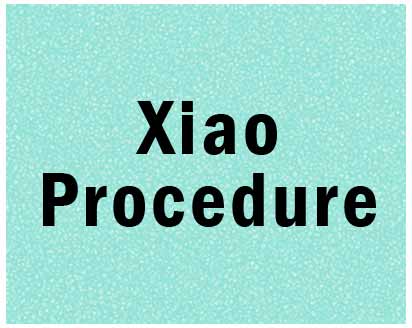- Home
- Editorial
- News
- Practice Guidelines
- Anesthesiology Guidelines
- Cancer Guidelines
- Cardiac Sciences Guidelines
- Critical Care Guidelines
- Dentistry Guidelines
- Dermatology Guidelines
- Diabetes and Endo Guidelines
- Diagnostics Guidelines
- ENT Guidelines
- Featured Practice Guidelines
- Gastroenterology Guidelines
- Geriatrics Guidelines
- Medicine Guidelines
- Nephrology Guidelines
- Neurosciences Guidelines
- Obs and Gynae Guidelines
- Ophthalmology Guidelines
- Orthopaedics Guidelines
- Paediatrics Guidelines
- Psychiatry Guidelines
- Pulmonology Guidelines
- Radiology Guidelines
- Surgery Guidelines
- Urology Guidelines
Double Blinded Randomized Controlled Trial of The Xiao Procedure in Children

Charlottesville : Researchers at Johns Hopkins All Children's Hospital report the results of a double-blinded randomized controlled trial of the "Xiao procedure" in children with spina bifida.
The multidisciplinary research group studied children and adolescents with myelomeningocele or lipomyelomeningocele who underwent spinal cord detethering with or without addition of the Xiao procedure to assess the procedure's effectiveness in achieving bladder control. Children with these types of congenital spinal cord defects frequently suffer from neurogenic bladder dysfunction, which may lead to lifelong urinary incontinence. The Xiao procedure was touted for many years in China as being more than 80 percent effective in such patients. In the present study population, the researchers found the procedure to be ineffective in all patients at producing bladder control. Full details of this study can be found in the article "Lack of efficacy of an intradural somatic-to-autonomic nerve anastomosis (Xiao procedure) for bladder control in children with myelomeningocele and lipomyelomeningocele: results of a prospective, randomized, double-blind study," by Gerald F. Tuite, MD, and colleagues, published online, ahead of print, in the Journal of Neurosurgery: Pediatrics.
Background
Myelomeningocele and lipomyelomeningocele are two forms of spina bifida, a neural tube defect in which spine components fail to develop normally during the first few weeks of gestation. In most cases of spina bifida, the lower portion of the spinal cord becomes tethered to inelastic structures, limiting its movement within the spinal canal. This can cause pain, muscle weakness, foot and spine deformities, and bladder and bowel incontinence. Although surgery is regularly performed to detether the spinal cord, some patients continue to have limitations in their walking ability and/or bladder and bowel function. The inability to control bladder and bowel functions hugely diminishes a person's quality of life. The potential of normalizing bladder function would be extremely valuable to patients affected by spina bifida, and this is what the Xiao procedure offered when first proposed.
The Xiao procedure, developed by Dr. Chuan-Guo Xiao, is designed to achieve bladder control in patients who suffer bladder incontinence due to spinal cord injury or spina bifida. During the procedure, a motor nerve leading from the spinal cord to the leg is rerouted and attached to a nerve leading to the bladder, creating a new reflex arc. If formation of the new reflex arc is successful, patients reportedly have been able to initiate urination by scratching their skin, which initiates the new spinal cord reflex. According to reports by Xiao and coworkers, the results of this procedure were excellent in 85 percent of patients with spina bifida after one year. Other surgical teams have had varied results, but the present study is the first in which a control group was used for a comparison.
Present Study
Tuite and colleagues studied the effectiveness of the Xiao procedure in pediatric patients (younger than 21 years of age) with neurogenic bladder dysfunction who required detethering of the spinal cord related to a myelomeningocele or lipomyelomeningocele. The researchers enrolled 20 patients into the study between 2009 and 2012, randomly assigning them to one of two surgical groups: 1) patients undergoing detethering of the spinal cord alone (DT, the control group) or 2) patients undergoing detethering of the spinal cord plus the Xiao procedure (DT+X, the experimental group). The study was double blinded because neither the patients, their families, nor research personnel who performed follow-up evaluations knew whether a particular patient had undergone spinal cord detethering alone or with the Xiao procedure. Before the study commenced, members of the research team traveled to China to observe Dr. Xiao perform the procedure, and Dr. Xiao supervised the first seven operations at the study center, Johns Hopkins All Children's Hospital, in Florida. The primary outcome of the study was the patient's ability to urinate voluntarily and/or in response to skin scratching.
Before surgery, all of the patients were bladder incontinent and none could void urine voluntarily or in response to a stimulus. During the three-year follow-up period, six patients four in the DT group and two in the DT+X group were able to urinate in response to skin scratching; however, this effect was sporadic and seemingly not directly attributable to the Xiao procedure. The authors state, "no patient in either group was able to void normally, reproducibly, or consistently during urodynamic testing at any point during the study period." In fact, the authors tell us that all patients required diapers or Pull-Ups throughout the 3-year period.
The negative finding of this study "raises doubts about the clinical applicability of [the Xiao] procedure." The authors believe that a return to basic science and animal studies should occur before future human trials of the procedure are performed. They emphasize the importance of further research to study the Xiao procedure and other nerve reinnervation techniques because of the major impact that bladder incontinence has on quality of life in patients with spina bifida, spinal cord injury, or other forms of neurogenic urinary incontinence.

Disclaimer: This site is primarily intended for healthcare professionals. Any content/information on this website does not replace the advice of medical and/or health professionals and should not be construed as medical/diagnostic advice/endorsement or prescription. Use of this site is subject to our terms of use, privacy policy, advertisement policy. © 2020 Minerva Medical Treatment Pvt Ltd